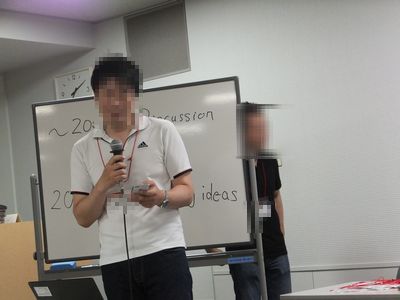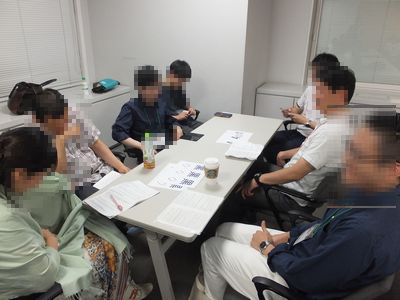1. マテリアルの紹介 Mさん

2. マテリアルの紹介 Mさん

3.ディスカッション中の様子

:::::::::::::::::::::::::::::::::::::::::::::::::::::::::::::::::::::::::::::::
《 今回のworkshop 》
○workshop参加人数:38名(うち新人の方:2名)
○【前半】: logical thinking
○【後半】:How should universities continue to educate students as the global and domestic situation demands?
:::::::::::::::::::::::::::::::::::::::::::::::::::::::::::::::::::::::::::::::::
みなさまこんばんは、E’s club幹事のKです。
8月5日(土) 開催の第155回workshopの詳細をお送りいたします。
今回は前半のマテリアルをMさん、 後半のマテリアルをMさんにご作成いただきました。
前半は”logical thinking”、後半は”How should universities continue to educate students as the global and domestic situation demands?” というテーマでそれぞれディスカッションを行います。
[今週のマテリアル]
≪FIRST HALF≫
Today’s topic is 「logical thinking」.
In business, sometimes we need to think logically. So I want you to think about these cases logically, and discuss them in your group. Think realistically. And also enjoy other person’s opinion.
At the last 5 minutes, I choose some groups and have you explain why your group think so.
Ex)
I agree A is B. Because,
1. ・・・・・
2. ・・・・・
3. ・・・・・
For these reasons, I think A is B
Case1:Is the complaint a treasure?
You are in the customer service in electric appliance company. Your job is receiving many complaints. It is very tough… and the boss always says that「the complaint is a treasure」. But your team member always say that「the complaint is just complaint」…..
Q:Do you agree that 「the complaint is a treasure」? Why do you think so? Persuade the people who have opposite opinion.
※Point:Why does the boss think 「the complaint is a treasure」. What information is the treasure? How do you use that information?
Csse2:Why is it necessary to change the training system.
You are in the personnel department. Your job is training new workers. The present training system was made 8 years ago. You think that system is old, so want to change the system. But your boss doesn’t think so….
Q:How can you persuade your boss? What points do you tell your boss?
※Point:If the training system were changed, what would happen? What is the company’s purpose?
≪LATTER HALF≫
[Agenda]
How should universities continue to educate students as the global and domestic situation demands?
Policies of higher education, especially universities, in countries are different and various. In some countries, entering universities are common, in others a few or there are alternative ways, such as entering vocational schools in Germany. Some offer higher educations at free of charge, others quite high.
Situations of economy or population in each country are also different and various.
In this current situation, how should japan maintain or develop higher educations, universities or not?
Please share your ideas for developing higher educations along with questionnaires focused on funding.
In the last 5 minutes to the end of a talk, I would like us to share ideas for Q5.
Please, show ideas of your table for everyone at the end of this.
Funding higher education by Takamitsu Sawa
http://www.japantimes.co.jp/ opinion/2014/05/25/commentary/ japan-commentary/funding- higher-education/
The percentage of Japanese high school graduates entering universities is not growing as fast as one would expect. Back in fiscal 1960 (April 1960 through March 1961), only 8.2 percent of those finishing high school joined universities, and the ratio remained at around 25 percent for 15 years between fiscal 1975 and fiscal 1990.
The percentage steadily grew in the ensuing two decades from 25.5 percent in fiscal 1991 to 51 percent in fiscal 2011. Since then, however, it has shown a downward trend, falling to 49.9 percent in fiscal 2013.
For the 34 member nations of the Organization for Economic Cooperation and Development (OECD), an average 62 percent of those finishing secondary education go on to study at universities.
The figure is highest – above 90 percent – in Australia, Iceland and Portugal, while it ranges between slightly above 65 percent and slightly above 75 percent in the three Nordic countries (Norway, Sweden and Finland), the United States, South Korea, the Netherlands and Denmark.
In Britain, 63 percent of high school graduates go to universities, which is about the same as the OECD average.
In countries such as Italy, France and Germany, those advancing to higher education account for between 40 percent and 50 percent of all high school graduates, a figure that is lower than in Japan. In these countries many students choose to go to vocational schools after finishing secondary education because, after becoming craftsmen with specialist skills, they are assured of a reasonable livelihood with a high social status.
At European universities, primary emphasis is placed on nurturing intellectuals, with vocational training taking a back seat. That is why the chances of university graduates finding jobs are not necessarily high.
The plateaued ratio of Japanese high school graduates pursuing higher education is attributed to high costs of studying even at national and other public universities, let alone private ones, when compared with Europe.
Expenses needed for studying at universities include the admission fee, tuition and the costs of lodging, food and transportation.
Universities in OECD-member nations, other than Japan, are well equipped with boarding facilities, enabling the students to live inexpensively. In Japan, however, dormitories accommodate only a limited number of students, forcing a large majority of students to live in apartments. It can cost close to ¥100,000 a month to rent an apartment that has easy access to public transportation in Tokyo.
Since most universities in Europe are run by national governments, students’ expenses including the living costs are kept low. This minimizes the chance of parents’ income levels causing gaps in children’s opportunities for receiving a higher education.
In the three Nordic countries, everything, including tuition and room and board, is free at all educational institutions – from kindergartens to universities and to graduate schools.
In most European countries, it is accepted that large portions of the cost of education should be shouldered by governments with taxpayers’ money. Since education is regarded as part of the most important lifeline, equal opportunities for education are ensured for children from poor families as long as they remain eager to learn.
In the U.S., on the other hand, tuition fees at private universities are quite high, with an annual national average reaching ¥2.51 million (assuming a conversion rate of ¥100 to the dollar). When the expenses for room and board and textbooks are added, the total comes to a whopping ¥3.74 million per year.
At state universities, tuition is discounted if students or their parents are paying state taxes. In these cases, the national average of the tuition for state universities is the equivalent of ¥660,000 per year. If other expenses are added, the annual total comes to the equivalent of ¥1.83 million, which is about the same as at Japanese national universities.
Universities in America also offer high quality scholarship programs. Students with excellent academic records are spared tuition costs, and are given stipends to pay for room and board. This enables youths from poor families to go on to universities.
Just as the tuition is high in the U.S., so is the standard of educational services offered by American universities. At both private and state universities, the ratio of students to faculty members is much lower than at Japanese universities, and American professors are paid about twice as much as their Japanese counterparts.
An international comparison shows that while European countries earmark sums equivalent to about 7 percent of their gross national product for school education, the comparable figure for Japan is a meager 3.6 percent.
This creates heavier financial burdens on students and their parents in Japan – one of the reasons why the ratio of high school graduates going on to universities is hovering around 50 percent.
Another reason for the relatively low percentage is that at certain private universities, a number of high school graduates who have passed entrance exams decline to be enrolled, because from their viewpoint of cost effectiveness, it is not worth paying such high tuition for education levels that are considered so low that diplomas from the universities will not assure them of good jobs.
This had led to the situation in which some 40 percent of all the Japanese private universities cannot fill their quota for students despite the fact that many private universities admit all applicants.
At universities where the number of students falls far below the quota, revenues from entrance examination fees, admission fees and tuition fall short of their estimates, thus creating a financial crisis that then makes inevitable a further deterioration in the educational standard of the services they offer.
In view of the excessive number of universities existing in Japan, some people call for more rigid rules on approving the establishment of new universities and departments.
I disagree because I think the best way to solve the problem is to follow the rule of the survival of the fittest. With the number of children in Japan continuing to dwindle, universities will have to overcome increasingly fierce competition to avoid bankruptcy. This will serve to elevate the average standards of educational services offered by Japanese universities.
There are three essential things Japan must pursue for higher education:
・Elevation in the ratio of high school graduates advancing to universities to the average OECD level.
・Drastic increases in government budget allocations for higher education with a view to improving the quality of education services provided at universities.
・Improvements in scholarships.
Through these measures, I hope that universities will fulfill their basic mission of nurturing professional experts with high levels of education, that higher education will become available to all young men and women who have strong motivations to study regardless of the financial status of their families, and that the overall intellectual levels of this country will be elevated.
Takamitsu Sawa is president of Shiga University.
[Questions]
1. Do you have any attachment to your “Alma mater*”?
Please share the reason why you feel so or not.
* Alma mater: a school, college, or university at which one has studied and, usually, from which one has graduated.
2. Should Japanese government increase budget allocations for higher education in shrinking its economy and population?
Please share your ideas.
* Refer to r1 and r2.
3. Should Japanese national and public, also even private* universities be more privatized or independent of governments more?
Please share your ideas of advantages or disadvantages.
* Private universities receive government subsidies for building and operating expenses at roughly 10% of annual expenses.
4. Have you ever donate money to universities?
Please share the reason why you do so or not. Including in the future, after your success or retirement.
* Refer to r3.
5. How will universities make money other than tuition fee?
What will be new sources of income for universities?
* Refer to r4 and r5.
6. According to a survey of inspection of fulfillment of a plan of new university establishment by MEXT, some universities were pointed out low quality of their education below university-level.
Should granted permissions of those universities be rescinded?
Please share your ideas.
* Refer to r6 and r7 (in Japanese).
7. How should the number of universities change as the number of 18 years old populations decreases?
[Extra]
1. How would you feel if your alma mater went bankrupt or were merged by other university?
* Refer to r8 (It’s in the case of U.S.).
2. If your alma mater were on the brink of bankruptcy, would you help it make a recovery or not?
If yes, how would you help it? Volunteer your time or donating goods or money or more.
[References]
1. http://www.mof.go.jp/tax_ policy/summary/condition/002. pdf
2. http://www.mext.go.jp/b_menu/ hakusho/html/hpab200901/ 1295628_005.pdf
3. http://www.japantimes.co.jp/ news/2014/09/09/world/h-k- family-gives-harvard-largest- ever-donation/#.WXbTtFFpyUm
4. https://www.sheffield.ac.uk/ finance/staff-information/ howfinanceworks/higher_ education/money
5. https://www.theguardian.com/ higher-education-network/blog/ 2012/mar/07/sources-of-income- for-universities
6. http://www.mext.go.jp/b_menu/ houdou/26/02/1344114.htm (Japanese)
7. http://d.hatena.ne.jp/ QZM03354/20140213/1392260536 (Japanese)
8. http://theweek.com/articles/ 467603/why-college-could- bankrupt
***********************************************************
私たちと一緒に英語コミュニケーション能力を鍛えませんか?
ご興味を持たれた方は、
入会申込フォーム
https://english-speaking-club.com/cms/?page_id=93
よりお申し込みください。お待ちしています!
***********************************************************